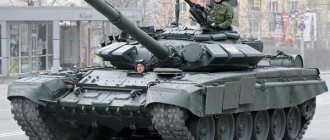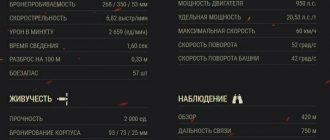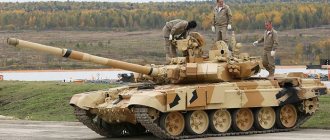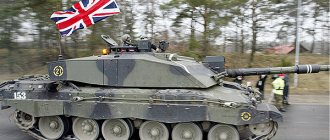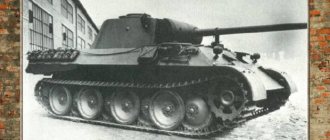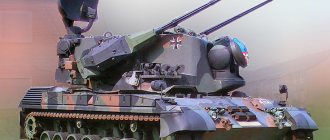The T-100 heavy tank was designed at the design bureau of plant No. 185 (Leningrad) under the leadership of S.A. Ginzburg (lead designer E.S. Paley) in 1938. By July 1, 1939, factory No. 185 produced a prototype of the tank, designated “Product 100.” During 1939 - early 1940, the T-100 was tested and took part in the Soviet-Finnish War. Subsequently, work on fine-tuning the T-100 tank was stopped in favor of the KV tank.
Description of the design of the T-100 tank
The T-100 tank (“Product 100”) had a general layout different from the classic one, with weapons placed in two turrets in a three-tier layout, located one behind the other. The tank's crew consisted of eight people, located: the tank commander - in the commander's cupola, the driver - in the bow of the hull along the longitudinal axis of the tank, the 76.2 mm gun gunner - in the main turret to the left of the gun; 45 mm gunner (turret commander) - in the small turret to the left of the gun; the tank technician is in the main turret behind the gunner, the radio operator is in the bow of the hull on the left side, the loaders are to the right of the guns in the corresponding turrets.
The tank's hull was box-shaped and assembled from armor plates 20 and 60 millimeters thick, connected by welding, riveting and goujons. A massive semi-conical turret box was mounted under the main turret in the central part of the hull. In the upper armor plate of the frontal part of the hull, a driver's inspection hatch with an inspection slot was located longitudinally. The hull roof consisted of four armor plates (two rear plates were removable). There is an entrance hatch in the forward armor plate of the hull roof on the front right, an antenna input on the left side, and a hole for the small turret running gear in the middle. There is a hatch in the armor plate of the engine compartment roof for access to the power plant. In the middle part of the roof of the transmission compartment there is a round hatch for access to the cooling system fan.
Two cast gun turrets, identical in design, conical in shape, located one after the other along the longitudinal axis of the tank, were assembled on goujons with welding of the joints of the armor parts. The towers are located on two levels. The first tier was formed by the front small tower with a horizontal rotation angle of 2450. The second tier was occupied by the main tower with a circular firing sector. On the roof of the main turret, to the right of the longitudinal axis of the turret, there was a commander's turret of circular rotation with viewing slots along the perimeter and a machine gun mount in the frontal part of the turret, with the ability to fire at air targets.
The main armament of the tank consisted of one 76.2-mm L-10 cannon, replaced in December 1939 by the L-11, installed in a mask mount mounted in the frontal part of the main turret, one 45-mm cannon mod. 1934, installed in a mask mount mounted in the frontal part of a small turret, three 7.62 mm machine guns, two of which are installed in the mask mounts of the turrets as coaxial guns and one is located in the machine gun mount of the commander's cupola. For aiming when firing from cannons and coaxial machine guns, periscope sights PTKU, PTK and TOP TP-1 were used; when firing from a machine gun in the commander's cupola, TOD and TZP sights were used. To monitor and adjust fire, the commander's cupola was equipped with a TPK commander's panorama. The tank's ammunition load was 120 76.2 mm and 393 45 mm cannon rounds and 4,284 machine gun rounds.
Read: Nagan revolver - features and capabilities
The power plant of the tank used a four-stroke twelve-cylinder liquid-cooled carburetor engine GAM-34-BT with a power of 850 hp. The tank's transmission was mechanical and included a three-disc main clutch, a manual gearbox (five forward gears and one reverse gear), two multi-disc side clutches, and two final drives.
The chassis of the tank, in relation to one side, consisted of one front idler wheel with a screw track tensioning mechanism, eight rubber-tired dual-slope road wheels with an individual crank-balancer suspension on leaf springs and a buffer spring (the first road wheel), five rubber-tired dual-slope supporting rollers, one drive wheel with a replaceable rear toothed ring and one small track with 710 mm wide tracks.
For external communications, a tank radio station 71-TK-3 is installed in the bow of the tank hull on the left side. For internal communication in the tank, a TPU-6 tank intercom was used.
Features of operation and maintenance
The T100 tractor must be operated according to universal rules (suitable for all crawler tractors):
- operate the equipment only while sitting in the operator’s seat;
- climb into the cabin only in the designated place, holding the handle near the cabin door and placing your foot on a special side platform;
- before starting work, make sure that there are no foreign objects in the tractor’s path of movement;
- to stop the device, use the brakes, first moving the gearshift lever to the neutral position, and only then engaging the brake;
- lower the implements after stopping the tractor;
- To maintain tracked mechanisms in proper condition, use special oil/grease;
- For operator safety, track tension is monitored visually, at a short distance from the tractor.
Oil or grease comes out of the release valve under high pressure and can cause injury if it comes into contact with the skin, so do not look at the release valve!!!
Maintenance of the T-100 caterpillar tractor is carried out according to the scheme:
- first service after 7 working hours (at the end of the shift);
- then after 120, 180, 240, 300, 360, 400 hours.
Actions performed by the operator during maintenance:
- clutch adjustment;
- adjusting the brake pedals;
- cleaning the outer surface of working units;
- replacing fuel filters;
- track adjustment (tension level).
When preserving a tractor for winter/seasonal storage, perform the following actions:
- drain the coolant;
- drain fuel sediment;
- all other fluids (from the windshield wiper reservoir, condensation from the air cylinder);
- move the control levers to neutral;
- turn off the battery;
- Place supports (beds) under the tractor so that the caterpillar part does not come into contact with the ground.
Main modifications of the T-100 tank
T-100 (“Product 100”) is an experienced heavy tank. Twice took part in the battles on the Karelian Isthmus in 1939-1940.
T-100Z (“Product 100Z”) is a heavy tank project designed under the leadership of L.S. Troyanov (leading engineer E.Sh. Paley) using the T-100 tank chassis at the end of 1939 - beginning of 1940. In April 1940, the main turret with weapons was manufactured. The production of the experimental tank was stopped in favor of fine-tuning the KV tank. It differed from the T-100 tank only in the new hexagonal turret, assembled from 60 mm thick armor plates connected by goujons, and the installation of a 152.4 mm M-10 howitzer in the mask installation of the main turret. The tank's ammunition load was 50 152.4 mm rounds for the howitzer and 393 45 mm rounds for the cannon and 4,284 rounds for machine guns.
“Object 0-50” is a heavy tank project designed under the leadership of I.S. Bushnev (leading engineer I.I. Agafonov) based on the design of the T-100 tank in 1939. In the summer of 1939, a wooden model of the tank was made. In 1940-1941, a prototype tank was manufactured. But due to the deployment of serial production at the LKZ of the KV tank, work on the Object 0-50 tank was stopped.
It differed from the T-100 tank:
– the tank crew consisted of four people; – placement of the main armament in one turret, with a armor thickness in the frontal part of 75 millimeters; – in the mask installation the following were installed sequentially: 76.2 mm L-11 cannon, 12.7 mm DK machine gun or 45 mm cannon mod. 1934, 7.62 mm DT machine gun; – the power plant used a four-stroke twelve-cylinder liquid-cooled diesel engine V-2 with a power of 500 hp; – the chassis used a blocked, four balancing bogies with two road wheels, a torsion bar suspension.
Development and release
The T-100 tractor, which received the short sonorous nickname “weaving” among users, is one of the most popular models of crawler tractors produced in Soviet times. The model was released between 1963 and 1983. Manufacturing plant: Chelyabinsk Tractor Plant. The prototype of the T-100 was the T108 tractor, which was produced in production under the name T100M.
Tractor T-100M
The device has a wide range of uses and can be combined with many types of additional equipment, for example, bulldozers, heavy-duty self-unloading trailers, cranes, rollers, and scrapers. The T-100 can also work with conventional agricultural equipment, such as a harrow, seeder, potato digger, etc.
Modifications
The T-100 tractor was originally intended for use in conjunction with a DZ-53 bulldozer. The base of the machine was used to create a pipe layer, crane and pile driver. During production, the Chelyabinsk Tractor Plant produced the following modifications of the T-100:
- T-100 is a basic tractor without hydraulic equipment and mountings for the rear linkage system. A winch was installed at the rear of the transmission housing;
- T-100MGS - modification for agricultural needs. The rear part is equipped with a linkage system and a power take-off shaft. The tractor has hydraulic equipment;
- T-100MGP is an industrial tractor with a front linkage system, hydraulic equipment, and a rigid coupling device in the rear instead of a winch. The machine was supplemented with output mechanisms for connecting the rear linkage system and the power take-off shaft;
- T-100B - swamp vehicle with tracks of increased cross-section;
- T-100BG - swamp vehicle based on the T-100MGP;
- T-100T is a pipe layer based on the T-100. Instead of the rear and front hydraulic suspension systems, mounts were installed for specialized machines and units;
- T-100MGP-1 - lightweight modification without a cabin;
- T-100MZGP - hydraulic servomechanisms for turning control have been added, making the driver’s work easier. The latest modification of the T-100, produced simultaneously with the T-130.
Get an advantageous offer from direct suppliers:
Attachments
Depending on the modification, the tractor is equipped with a hydraulic linkage on the front or rear of the frame. A rigid rear hitch was used on some versions of the machine. An early version of the T-100 bulldozer was equipped with a cable control blade. To operate the mechanism, designated D3-53, a winch mounted on the frame of the machine was used. The later version of the D3-54 began to be equipped with a hydraulic blade drive. Bulldozers were widely used to prepare pits in conjunction with an excavator.
The tractor was rarely used as an agricultural machine due to its heavy weight and low speed. During the movement, a deep rut was formed, which made it difficult for combines and other equipment to move. Therefore, the tractor was used for plowing virgin lands and as a soil loosener.
Special equipment could be installed on the tractor base - pile drivers, drilling rigs. There were versions equipped with pipe layers.
T-100M ChTZ produced in 1963-1983: technical specifications, review, description
Photo source: techstory.ru Photo ChTZ T-100 The full name of the T-100 is T-100M.
Initially, the vehicle, developed on the basis of the earlier S-100 model, was to be called the S-100M (“S” stands for “Stalinets”, “M” for “modernized”). However, by the time the tractor was released, it was decided to abandon the use of the Stalinets brand. The main industry in which the tractor was used was construction. It was also used in agriculture, but was inferior to specialized agricultural machinery in terms of speed.
In parallel with the production of the T-100, the plant’s designers were developing the T-130 model, which gradually replaced the “weaving” from the production program of the enterprise.
Reviews and prices
Since tractor production has ceased, only used equipment can be purchased. The cost of the car depends on the condition and additional equipment installed by the previous owners. The price of a tractor ranges from 150 to 500 thousand rubles.
Dmitry, Tver region
To clear forest plots, a T-100 manufactured in the mid-70s is used. The tractor is well suited for uprooting stumps and laying forest roads. Disadvantages include tight controls that require physical effort. In winter, the cabin is cold because there is not enough heat from the engine. Unscheduled repairs are rare; the machine requires timely maintenance.
Advantages and disadvantages
The features of the tractor determine the positive aspects of the machine:
- high traction characteristics;
- good cross-country ability on weak and marshy ground;
- simple design that does not require qualified maintenance;
- reliability;
- possibility of equipping with various attachments.
The disadvantages of T-100 machines include:
- uncomfortable operator's cabin;
- loss of machine traction when operating in high gear;
- low speed of movement;
- lack of hydraulics (on a number of modifications);
- destruction of hard surfaces by caterpillars.
Engine
The power of the power unit of the T-100M tractor, the first sample of which was assembled on October 9, 1963, was 108 hp. Engine model - D 108, type - 4-cylinder 4-stroke. This engine was more economical in comparison with the one installed on the previous model: specific fuel consumption decreased to 173 - 175 g/e.h.p.h. In particular, this was achieved thanks to the introduction of mixture formation with direct fuel injection. Pre-chambers were no longer used in the engine design, and injectors began to be installed directly into the cylinder heads (special bushings were provided for this). The function of turning off the diesel supply to the second and third cylinders when switching to idle helped to further reduce fuel consumption.
Photo source: techstory.ru Engine power exceeded 100 hp.
Let's talk about other features. Since the combustion chamber was now located at the bottom of the piston, the fuel injection pressure had to be increased to 200 kgf/sq.cm. Previously, a spherical combustion chamber was installed, one of the hemispheres of which was located in the upper part of the cylinder, the second in the piston.
The engine compression ratio was reduced to 14. The valve mechanism parts were also modified. The starting engine, called P 23, was equipped with an ST 204 starter.
In the future, the D-108 engine was widely used in the design of other equipment, for example, in the production of compressor stations and diesel generators. It was also equipped with E-10011 excavators.
Basic faults and repairs
When operating the T-100 crawler tractor, the operator may encounter various malfunctions. The following list shows the most common problems and how to fix them:
- engine running intermittently (not warmed up, lack of fuel, clogged fuel line and filter - warm up the engine, check the fuel level, replace the filter, clean the fuel line);
- engine knock (valve clearance adjustment);
- smoky exhaust (bad fuel, water getting into the fuel, cold engine - warm up, replace fuel);
- increased oil consumption (the location of the piston rings is adjusted, oil leakage is eliminated);
- carburetor malfunctions (adjustment, debugging in progress);
- slipping of the clutch (it is necessary to wash the friction linings with kerosene);
- heating of the brake bands or the brake not working when pressed (repair: adjusting the brakes, washing the side clutches without turning them on).
Links
Ivan Savvateevich Kavyarov (August 18, 1913, Makushino, now Kurgan region - July 14, 1980, Chelyabinsk) - Soviet design engineer, Doctor of Technical Sciences, professor. Participant of the Great Patriotic War, Guard Major.
T-100:
T-100 (tank) is an experimental Soviet double-turret heavy tank from the late 1930s.
T-100 is a complex installed on Product 64992: an experimental Soviet tank of the 1960s.
T-100 (tractor) - industrial tractor, produced by the Chelyabinsk Tractor Plant.
T-100 (tank destroyer) - Egyptian tank destroyer based on the T-34-85.
T-100 (teletype) is an electromechanical printing machine for sending and receiving text messages.
T-130 (T-10.01, tractor drivers often traditionally call the tractor T-100, or even S-100; colloquially - “weaving”) is a Soviet agricultural and industrial tracked tractor produced by the Chelyabinsk Tractor Plant. It is a deep modernization of the T-100 tractor. The tractor was produced in two modifications: conventional and swamp-moving (T-130B) with an increased track area.
The tractor is used as part of a bulldozer-ripper unit, and also as a base machine for a pipe layer and pile driver.
A further development of the T-130 tractor was the T-170 model, with its horsepower increased to 174. engine power.
There is an agricultural modification T-170MGS for plowing rice fields.
The tractor has 8 gears.
The T-130 and T-170 tractors deserve mixed reviews. Their advantages include simple design and low cost (compared to tractors of a similar class). At the same time, by the time mass production began, the tractor design, “rooted” in the 30s, was already seriously outdated. The mechanical transmission did not allow the engine to fully realize its power when working under high loads and complicated the process of controlling the tractor. The semi-rigid suspension also did not allow the tractor to realize the traction potential of the engine either through speed or traction. The service life of the onboard clutches, which have not undergone changes since the time of the S-80 tractor, in the T-130 tractor, and especially in the T-170, turned out to be extremely short. The diesel engine was started by an archaic starting four-stroke two-cylinder gasoline engine, which, in turn, was not so easy to start, especially in cold weather. The control levers and pedals, which acted directly on the transmission elements, vibrated strongly during operation. Tractors of a similar class, produced abroad in those years (USA, Japan), already had in their basic configuration a hydromechanical transmission, elastic suspension, a sprung sealed cabin, and remote control of the transmission and chassis, which eliminated the transmission of vibrations to the controls.
| Tractors of the USSR | |
| Wheeled vehicles for wide application |
|
| Wheeled universal |
|
| Crawler agricultural |
|
| Tracked industrial |
|
| Skidding |
|
| Army |
|
